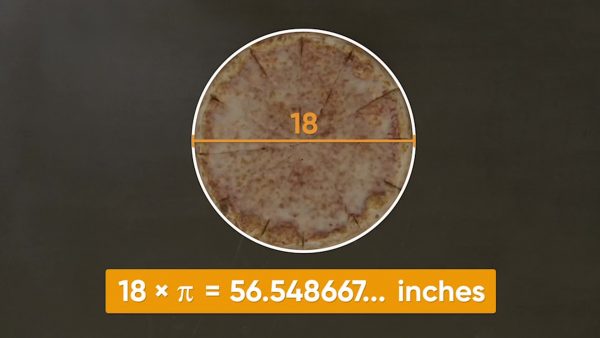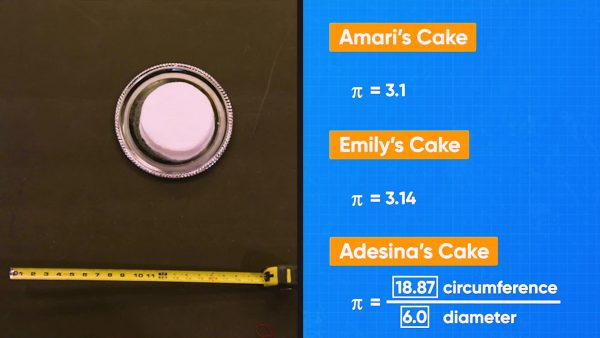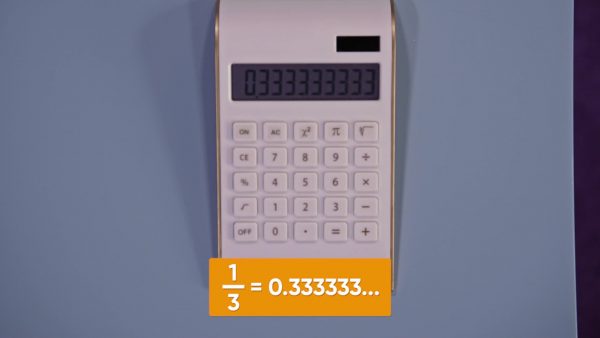
Rational numbers are numbers that can be represented with fractions (or ratios). Irrational numbers are numbers that cannot be represent with fractions. “Irrational” means “non-rational.”
To better understand irrational numbers…
LET’S BREAK IT DOWN!
π is an irrational number.

Adesina, Emily, and Amari are eating pizza. Amari wants to find the length of crust on their pizza. You can use the formula C = πd to find the circumference of the pizza, where C is the circumference and d is the diameter. The diameter is the distance across the center of the circle. The pizza has diameter 18 inches. The circumference of the pizza crust is C = πd = π(18) =56.54866776461628… The reason there are so many decimal places when you work with π is because π represents an irrational number. Try this yourself: Calculate the circumference of a circle that has diameter 17 inches.
You can use known measurements to calculate π.

Adesina, Amari, and Emily are decorating cakes, and exploring the value of π. π is the ratio between the diameter of a circle and its circumference, π = [ggfrac]C/d[/ggfrac]. To determine the value of π, they decide to measure the circumference and diameter of their cakes and use their ratio to calculate π. Amari measures her cake and finds that the cake is 31 inches around and 10 inches across. She finds that the value of π is π = [ggfrac]C/d[/ggfrac] = [ggfrac]31/10[/ggfrac] = 3.1. Emily uses a more accurate tape measure on her cake and finds that the cake is 15.7 inches around and 5 inches in diameter. She finds that the value of π is π = [ggfrac]C/d[/ggfrac] = [ggfrac]15.7/5[/ggfrac] = 3.14. Next, Adesina measures her cake using an even more accurate tape measure. Adesina’s cake is 18.87 inches around and 6 inches in diameter, so her value of π is π = [ggfrac]C/d[/ggfrac] = [ggfrac]18.87/6[/ggfrac] = 3.145. All of their answers are close, but the varying accuracy of their measurements give them values for π with different levels of accuracy. If they used more precise scientific equipment, then they would have found π = π=3.14159265358979… The decimals in the number π go on forever and never repeat, which means it is an irrational number. Irrational numbers have decimals that go on forever and never repeat. We use the symbol π because it is a much more compact way to represent this irrational number. Try this yourself: Calculate π for a circle with circumference 62.8319 inches and diameter 20 inches.
Square roots of numbers can be irrational.
Repeating and terminating decimals are rational.

Emily converts [ggfrac]1/3[/ggfrac] to a decimal and gets 0.333333333… Is [ggfrac]1/3[/ggfrac] irrational? The decimal is endless, but the 3 in the decimal part repeats, so 13 is not an irrational number; it is a rational number. Rational numbers are numbers that can be written as a ratio of integer values. Their decimal form either terminates or repeats. You can summarize a repeating decimal by putting a bar across the repeated values, so 0.33333333333 becomes 0. 3. Emily then finds the decimal form of [ggfrac]2/3[/ggfrac] and gets 0.66666666, or 0.6. Likewise, [ggfrac]34/99[/ggfrac] becomes 0.3434343434, or 34. These are all rational numbers. Try this yourself: Identify whether each number is rational or irrational. 0.94, 0.65475694, [ggfrac]38/99[/ggfrac], 23.573659312859362843…
IRRATIONAL NUMBERS VOCABULARY
IRRATIONAL NUMBERS DISCUSSION QUESTIONS
What is a rational number?
What is an irrational number?
If an irrational number has infinitely many decimal places, how can I possibly use it?
Sort the following irrational numbers from least to greatest by converting each one to a rational approximation. 3.758375839203…, √22, [ggfrac]√20/4[/ggfrac], 3√2
Show that any terminating decimal can be written as a fraction with a base-ten denominator.
Example: [ggfrac]2.55676/1.00000[/ggfrac] = [ggfrac]2.55676x100,000/1.00000x100,000[/ggfrac] = [ggfrac]255,676/100,000[/ggfrac]
Skip, I will use a 3 day free trial
Enjoy your free 30 days trial
We use cookies to make your experience with this site better. By using this site you agree to our use of cookies. Click "Decline" to delete and block any non-essential cookies for this site on this specific property, device, and browser. Please read our privacy policy for more information on the cookies we use.Learn More
We use cookies to improve your experience. By using this site, you agree to our use of cookies. Click "Decline" to block non-essential cookies. See our privacy policy for details.Learn More






